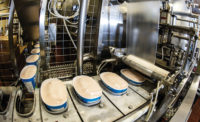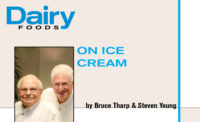In our May column, we discussed the so-called “rare” sugars. These are sugars found in nature but at ultra-low levels. The most commercially available rare sugars are tagatose and allulose, recognized as providing sucrose-like sweetness (~ 0.90 and ~0.70, respectfully) at significantly lower caloric contributions (1.5 and 0.20 calories per gram, respectively).
Recently, the Food and Drug Administration announced its Final Ruling on the updating of nutritional labeling. This included new definitions, labeling options and, in some cases, standard serving sizes. For ice cream and related products, the revised serving size is 6 fluid ounces (up from 4 ounces) for packaged products.
The FDA’s Final Ruling requires the inclusion of “added sugars” in the reporting of Nutrition Facts. “Added sugars” is considered to be the sum of all mono- and disaccharides not expected to be naturally found in the food and primarily added for sweetness and/or other functionalities. FDA also established a Daily Value (DV) for added sugars of 50 grams, based on the position that added sugars should not contribute more than 10% of the 2,000 calories considered to represent a daily diet.
Wide-ranging effects
In product reformulation responsive to the influence of the increased serving size and the objective of maintaining minimal levels of added sugars, the requirement to declare the level of added sugar in relation to its DV adds importance to the consideration of laws of chemistry and physics that affect key properties, such as those that manage freezing point, protein interaction and fat agglomeration. Ultimately, sensory appeal of the final product is affected.
The key benefits of rare sugars are to achieve significant reductions in calories and/or added sugars. Further, with the new 6 fluid-ounce standard serving size for packaged products, interest in reducing added sugars in nearly all frozen dessert compositions and formats is expected to be particularly great.
However, the characteristics of rare sugars clash with the provisions of the nutrition labeling changes with regard to the calculation of the percent Daily Value (% DV) from added sugars. Although the level of added sugars is shown in grams, the % DV value is based on the caloric contribution, assuming a value of 4 calories per gram represented by sucrose and other common nutritive sweeteners.
The calculation of % DV for nutrition-labeling purposes is straightforward if (and it’s a big if) all added sugars contribute 4 calories per gram, as do classical sugars like sucrose. No provision is made for products in which rare sugars (which contribute less than 4 calories per gram) are present as added sugars. For those sugars, the difference between % DV based on grams and % DV based on calories is significant. For example, at 4 calories per gram, the DV for added sugars is 50 grams per person per day. For allulose, at 0.2 calories per gram, the same reported grams of added sugars would have a calculated DV of 80% less than that for classical “sugars.” That is a five-fold difference to the benefit of allulose! Clearly, this shortcoming needs clarification.
Challenges of using rare sugars
Beyond that, when using rare sugars to manage levels of added sugars, care and proper formulating remain critical. Key challenges requiring attention are discussed below.
Freezing Profile. Tagatose and allulose are monosaccharides, for which the freezing point depression is about double that of disaccharides like sucrose. When reformulating, to minimize freezing point depression effects, we recommend limiting freezing point changes to less than 0.5 F.
Water Control. Although rare sugars have negligible influence on water mobility, changes can occur as a result of compositional modifications that affect total solids and change the influence of freeze concentration on the composition of the unfrozen portion of ice cream.
Sweetness. Sucrose-like sweetness is highly desirable. However, the more tagatose and allulose are considered, the greater is the effect on the overall sweetness and the potential for a more negative influence on added flavors. That consideration also applies when there is a need for bulking agents or non-sugar sources of sweetness (for example, stevia, monk fruit, thautamin and variants thereof).
Total added sugars. As the need for reduction in added sugars increases, the management of both added sugars and calories from added sugars becomes increasingly critical to success.
This is a lot to manage all at one time. We suspect rewards will be found for those who properly manage the principles under which the challenges arise.
To learn more about rare sugars and their utility in sugar-modified and calorie-modified ice creams and related products, plan to join Dr. Bruce Tharp and Dr. Steven Young at “Tharp & Young on Ice Cream: Technical Short Course, Workshops, and Clinics” from Nov. 30 to Dec. 2 in Las Vegas. Class size is limited, so register now. For more information go to www.onicecream.com or call 610-975-4424 or 281-782-4536.




